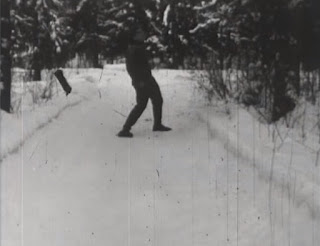... aka: Lumberjack
... aka: Woodcutter
Directed by:
Evgeniy Yufit
The director's second short following his 3-minute-long WEREWOLF ORDERLIES (1984), this was an early entry in the Soviet Necrorealism / Parallel Cinema underground movement, which was basically started as a means to revolt against oppressive state control over their film industry, which included not just film production but also distribution.
The two-and-a-half minute intro features a TV reporter (played by the director himself) entering a small room that's decorated in creepy fashion with pictures of corpses, crime scene photos and skulls adorning the walls, hanging dolls, a stabbed teddy bear and other such ghoulery. He addresses the camera directly and starts talking but we don't hear anything because he doesn't have his microphone hooked up. Once he plugs it in, the camera suddenly cuts away. Even though nothing has really happened up to this point, this is already (visually) an improvement over Yusif's first short in that it's filmed and lit somewhat better and features actual art direction so at least it has that much going for it. This is still primitive stuff on the technical scale though... and the film seems to become even more primitive the further along it goes. So why the sudden change in quality? Well, the print of the original film currently sitting in archive runs 6 minutes while the one I viewed runs over 8, which means this better-shot opening sequence must have been grafted on at a later stage.
We meet a nameless man who is having a hard time walking down an icy road. He's one of many who have a zombie-like lurch to their gait. The basic task of walking becomes even more difficult when a mob dressed in back run by, push him down, tie a rope to his leg and start dragging him. We then go to an apartment building where a man tosses a dummy off a balcony. The title card informs us that despite the dummy's high fall, it "continued to function well." The dummy is then hung from a tree, put on train tracks and then saved from being run over but "dies" soon after anyway. The body is buried in the snow.
A "pseudo-tourist loser" on an excursion in the woods stumbles onto the body and the mob of men come and start beating him up. And then beat each other up. And then beat up a guy carrying a dead body on his back who in turn is beating up another guy with a briefcase who looks like he's about to picnic in the snow. We get brief flashes of a crazy tied-up man, a guy in drag dancing and some other such nonsense before learning that the "pseudo-tourist" is actually a "werewolf double." The real tourist has devoted his life to being a woodcutter. He stumbles around, knocks down some trees and collapses from exhaustion. Just another day for the working class. The mob then start flailing in the snow, punch and kick each other and hit each other with sticks while stock footage people release doves, point and cheer.
Cut between the frantic action are various stills and brief clips from films, shots of bugs eating a dead lizard, slaughtered pigs, an angry bear and more. It's all a deep and profound statement about... uh... well, scratch that... This is really just filmed anarchy against Soviet ideology, with people running amok engaged in poorly-choreographed depictions of suicide, murder and slapstick brawling accompanied by a tuneless song. The title cards somehow make it even less coherent than it otherwise would be, which is probably the point.
I always have a difficult time rating stuff like this. It has a certain historical significance and provokes some interest on that front. However, as much as I fully respect what these folks were doing, where they were doing it and why they were doing it, I appreciate what this symbolizes much more than the execution of the film itself.
★1/2

































































